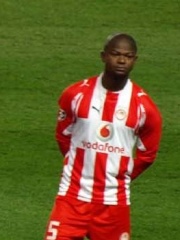 São Luís, Maranhão
São Luís, Maranhão
São Luís, Maranhão ranks 760th in number of biographies on Pantheon, behind Greenwich, Exeter, and Ipswich. The most famous people from São Luís, Maranhão are Augusto Tasso Fragoso, Ferreira Gullar, and Luís Oliveira. São Luís, Maranhão has been the birth place of many soccer players, and politicians. São Luís, Maranhão is located in Brazil.
São Luís is the capital and largest city of the Brazilian state of Maranhão. The city is located on Upaon-açu Island or Ilha de São Luís, in the Baía de São Marcos, an extension of the Atlantic Ocean which forms the estuary of Pindaré, Mearim, Itapecuru and other rivers. Its coordinates are 2.53° south, 44.30° west. São Luís has the second largest maritime extension within Brazilian states. Its maritime extension is 640 km. The city proper has a population of some 1,088,057 people. The metropolitan area totals 1,536,017, ranked as the 15th largest in Brazil. Read more on Wikipedia
People
Between 1869 and 1999, São Luís, Maranhão was the birth place of 22 globally memorable people, including Augusto Tasso Fragoso, Ferreira Gullar, and Luís Oliveira.
People Born in São Luís, Maranhão
Go to all RankingsAugusto Tasso Fragoso
POLITICIAN
1869 - 1945
HPI: 59.79
Rank: 1
Ferreira Gullar
WRITER
1930 - 2016
HPI: 53.16
Rank: 2
Luís Oliveira
SOCCER PLAYER
1969 - Present
HPI: 52.01
Rank: 3
Júlio César
SOCCER PLAYER
1978 - Present
HPI: 47.52
Rank: 4
Pabllo Vittar
MUSICIAN
1993 - Present
HPI: 46.18
Rank: 5
José Clayton
SOCCER PLAYER
1974 - Present
HPI: 46.15
Rank: 6
Abuda
SOCCER PLAYER
1986 - Present
HPI: 44.54
Rank: 7
Válber Costa
SOCCER PLAYER
1971 - Present
HPI: 44.09
Rank: 8
Thiago Mendes
SOCCER PLAYER
1992 - Present
HPI: 42.67
Rank: 9
Léo Silva
SOCCER PLAYER
1985 - Present
HPI: 41.91
Rank: 10
Ananias Eloi Castro Monteiro
SOCCER PLAYER
1989 - 2016
HPI: 41.52
Rank: 11
Dyego Sousa
SOCCER PLAYER
1989 - Present
HPI: 38.26
Rank: 12
Newly Added People Born in São Luís, Maranhão
Go to all RankingsOccupations
Most individuals born in present day São Luís, Maranhão were soccer players (17), politicians (1), writers (1), musicians (1), and handball players (1), while most who died were .
Occupational Trends
Over the past 100 years, soccer players have been the top profession of globally memorable people born in São Luís, Maranhão, including Luís Oliveira, Júlio César, and José Clayton. Whereas, throughout history, soccer players have been the profession with the most memorable people born in present day São Luís, Maranhão, including Luís Oliveira, Júlio César, and José Clayton.
Places
Overlapping Lives
Below is a visual represetation of the lifespans of the top 3 globally memorable people born in São Luís, Maranhão since 1700.














